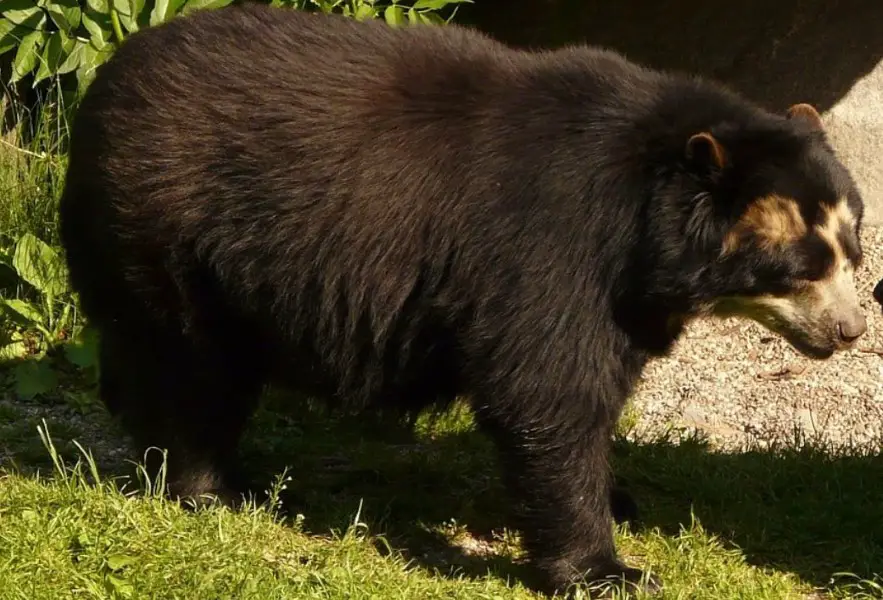If you’ve heard of spectacled bears, then you may wonder if a spectacled bear could overpower and kill a human, or if they would attack a human at all? In this post, we’re going to answer that exact question for you.
First of all, here’s the quick takeaway answer, then we’ll go into more detail…
Are Spectacled Bears Dangerous? Spectacled bears are the least dangerous bear compared to other bear species. They are shy, elusive mammals and non-territorial, who prefer solitary. Although spectacled bears are naturally non-aggressive, calm and submissive, they do attack for self-defense and mainly for protecting their young.
Spectacled bears are named after the spectacled shaped black fur surrounding the eyes as if they are wearing spectacles.
There are one of the most endangered bear species in the world. They’re also known as “Andean Bears” and are heavily distributed in the Northern Andes Mountain.
Spectacled bears are the living kin of the short-faced bears of the Middle Pleistocene to Late Pleistocene age. In a world where bears are always seen as dangerous creatures, these spectacled bears appear to be the most placid and innocent.
That being said the below article will go through the questions that may be popping in your mind about spectacled bears.

General behavior
To begin with, spectacled bears prefer roaming the rain forests, jungle areas, and other dryer and more forested areas foraging for food.
Long term observations also show that these bears have amazing skills to understand where and when their favorite food can be available, which makes these animals an intelligent creature with good problem-solving skills.
However, despite intelligence, these bears are non-territorial…
Usually, there is a commonly accepted perception that territorial animals more readily present aggression, anger, and defensive traits.
Also since territorial animals are consistently in the need to protect their territories a sense of calmness is less common in such animals and they’re more easily provoked or triggered to aggressive behavior.
As such, the spectacled bear not being territorial makes these cute creatures non-aggressive and calm by nature.
These bears are also solitary animals who prefer to be alone – minding their own businesses. The very rare instances where these bears can be seen in sociable settings are mainly when feeding together, mating and taking care of their young.
They also tend to care for their young only as long as three years and then revert back to solitude again.
Even when you see spectacled bears as a group, you can easily observe these bears having a calm and quiet interaction with each other without conflicts. These solitary behaviors mean that there is probably minimal intercommunication between spectacled bears.
As such spectacled bears spend their life as a non-territorial and mostly solitary creature that presents little to no characteristics of danger, aggression or behavior that could be harmful to human beings.
Are spectacled bears shy or scared of humans?
The spectacled bear is one of the only remaining species of bears that are diurnal. However again due to their shy nature, they prefer to stay clear when they sense human activities around.
Researchers suspect these bears could be more nocturnal. The researchers also found it difficult to spot them during the day in the lush cloud-covered forests of the Andes. Therefore, spectacled bears have really always been an under-researched animal and less is known about this shy creature in the wild than other bears.
Being non-territorial, spectacled bears tend to maintain a distance between humans. They prefer maintaining this distance not because they are scared of humans because they’re shy and prefer staying in their comfort zone in solitude.
But, when these bears see humans they get excited and curious, not in an aggressive way but in a submissive way.
In fact, they use the fur around their eyes giving a spectacled look like a mask to hide their eyes to avoid eye contact with humans – they are just too shy even to make eye contact!
They can be encouraged to come closer by offering them food – like fruits and plants.
However, even though these gentle animals present no danger to humans and like to maintain a distance from humans, they are sadly heavily hunted. And like any other living being that will want to defend itself, these animals will try to save their own lives.
As such there are instances where spectacled bears can be dangerous and liable to attack. However, yet again when compared to other types of bears, spectacled bears have the least reports of attacks or harm inflicted on humans.
Reports of spectacled bear attacks
Many spectacled bear attacks that have been reported have one thing in common.
Spectacled bears tend to attack only at the extreme end of self-defense. Spectacled bear attacks are barely reported as being spectacled bear attacks due to aggression.
Spectacled bears rarely get provoked and so there’s very little chance of them attacking someone as a result of provoking or triggering anger – unless it comes down to saving their own life.
One case of a spectacled bear attack was because a spectacled bear fell on a hunter and the hunter shot him, the hunter also died. Another similar incident saw a spectacled bear attack a woman. She encountered the bear suddenty in a cornfield, and the bear bit her on the cheek, she managed to chase the bear away. This also demonstrates an attack by extremes of self-defense.
Now, spectacled bears are protected species and attacking or hunting one could result in a prison sentence.
Apart from these instances, the only and most intense situation where spectacled bears are said to be aggressive is when it comes to protecting their young – after all, being like most other mothers they will ferociously protect their offspring.
Many believe that this bear naturally presents no harm. A well-renowned case for this is that when a spectacled bear escaped Berlin Zoo in 2004. The bear headed to the children’s area of the zoo and was playing with a bike – showing no threats or even danger to the people or even kids around.
The zoo’s deputy director clearly said she didn’t fear the escape as the animal shows no real danger after all.
Culturally related, these animals are never seen as a threat. It’s believed that spectacled bears protect pilgrims on their pilgrimage to Q’oylluriti (a festival held high in the Andes mountains), especially pilgrims such as musicians and dancers.
These bears are considered a manifested guardian between the god of the mountain and the people in their festivals. It’s believed that these bears oversee if festivals are going as planned with minimal disturbances.
Now to the final question – could they attack a human?
Size, gender, and capacity to attack humans?
The spectacled bear is one of the largest mammals in South America and so they have all the physical capacity for attacking. They mostly make use of their weight for attacking along with their sharp teeth and claws.
However, a female spectacled bear is smaller and weighs one third less when compared to a male. A male is a comparable weight of about 2 and a half average men, weighing in at up to 353lb (160 kg) while the female weighs between 176lb – 198lb (80 – 90 kg).
Despite being of a lower weight, a female spectacled bear uses all her weight as strength against an assailant when it comes to attacking or protecting their young.
Learning resources
We’ve found the ideal resources to continue your learning at home and at school on amazon. Help support our efforts for wildlife causes and keep this site working for nature. Amazon also donates to wild-life related charities!
A good resource for early report writers. This book presents information about South America’s spectacled bears, their forest habitats, and their distinctive fur patterns. Fun facts add information and create a multi-level reading experience
Video resources
To conclude
We shouldn’t be scared of the Andean Bear, they’re harmless and in fact, would probably rather not be near you, but food and activity may attract them. As long as you do not provoke them then they are fine. But give them the space they need and admire them from afar would be our recommendation.
This content has been checked and verified by a qualified veterinary practitioner. The article has been reviewed by our editorial team and has been approved for publication in accordance with our editorial policy.
